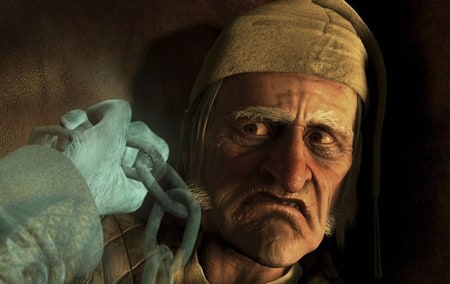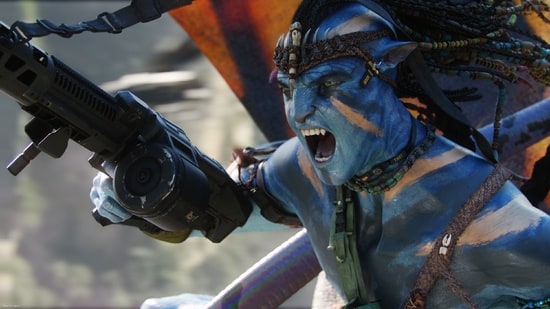It's doubtful that any Christmas story is as omnipresent as Charles Dickens's A Christmas Carol. Since cinema's very inception, there have been tonnes of motion picture adaptations of this 1843 novella, as well as spoofs and updated variations (the Muppets, Mickey Mouse and even Mr. Magoo have all tackled this Yuletide morality tale). In addition, the characters are ingrained so deeply in popular culture that one only has to utter the name "Scrooge", and the vast majority of the human populace will immediately conjure up images of a grumpy, miserable old curmudgeon who dampens the spirits of those around him. Therefore, it's logical to ask why the world needs another screen version of A Christmas Carol.

The answer is simple: Robert Zemeckis' 2009 picture is a Disney-branded, computer-animated spectacle (in 3-D) appropriate for the digital era. A Christmas Carol is Zemeckis's third attempt at reimagining page-bound stories with cutting-edge performance capture technology to turn flesh-and-blood actors into infinitely malleable digital avatars (his previous efforts being The Polar Express and Beowulf). It's hard not to be impressed with the top-shelf animation, but Zemeckis' A Christmas Carol is nevertheless flawed.
(Synopsis is mostly taken from my review of the 1984 version because I can't be bothered writing another synopsis of the same fucking story)
The embittered old Ebenezer Scrooge (Jim Carrey) is one of the cruellest men in London, and Christmas is his least favourite time of the year. With Christmastime upon him yet again, Scrooge could not care less; he's far more concerned with running his business and torturing assistant Bob Cratchit (Gary Oldman). Upon his arrival home on the evening of Christmas Eve, Scrooge is visited by the ghost of his late business partner Jacob Marley (Gary Oldman again), who warns the old man that his miserly ways may lead to his soul being tormented for eternity. As the night wears on, Scrooge is visited by the Ghost of Christmas Past (also Jim Carrey), the Ghost of Christmas Present (Jim Carrey again) and the Ghost of Christmas Yet to Come (still Jim Carrey), who take the bitter man on a grim time-travelling journey.

Zemeckis' script is remarkably faithful to Dickens' original novella, down to insignificant moments and most of the dialogue. This fidelity instantly creates a problem, though. The Victorian English from the original text vastly differs from modern English in terms of grammar, words, syntax and rhythm. Hence, the dialogue here is quite dry, and children will no doubt have trouble deciphering what's being said. Dickens also used societal commentary in his story, which erroneously transfers to Zemeckis' adaptation. The most glaring example is an out-of-place digression in which Scrooge and the Ghost of Christmas Present take time out of their journey to discuss "Sabbatarianism" (the practice of closing businesses on Sunday). Presented in this flick without any specification as to what is being discussed more than a century after it stopped being controversial results in a huge "What the fuck?!" moment. Books should be altered for their translation to the screen. Take the 1984 version of A Christmas Carol - the makers changed the dialogue to give it an engaging new spin, and the result is both spiritually faithful to the novella and more comprehensible.
Sticking slavishly to Dickens' novella could have worked, but Zemeckis wasn't just aiming for a loyal page-to-screen transplantation; A Christmas Carol also aspires to be a flashy, adamantly Hollywoodised 3-D blockbuster with broad appeal. Thus, the film tries to have it both ways, with elaborate set pieces and moments of inane physical comedy. To pander to the 3-D gimmick, Zemeckis overplays the action a few times to underscore various things in an unnecessarily obvious, overdone fashion when a more low-key approach would have sufficed (an elongated chase through the streets of London is the most egregious - it's borderline painful). It's clear that this material is present to keep the kids awake, but the picture as a whole is too scarifying and dark for tots.

Oddly enough, however, A Christmas Carol still gels for the most part, as the most offensive action only occurs in the final third. Furthermore, director Zemeckis is astonishingly competent at staging expositional scenes, making the dry dialogue less of a problem. This is also a technically jaw-dropping picture. The film opens with a superlative tracking shot that takes us on an aerial tour of Victorian-era London. A Christmas Carol was released in 3-D, with extraordinary extra-dimensional effects. The glasses may be a nuisance, but the most memorable and enjoyable way to experience this picture is in 3-D. The score by the criminally underrated Alan Silvestri also deserves credit, as it encapsulates the flavour of the Christmas season (it even contains notes from various Christmas carols) on top of carrying a general old-fashioned 19th-century aura. On a less positive note, characters in motion capture movies are often plagued by "dead-eye syndrome", and (despite technological advancements since 2004's The Polar Express) A Christmas Carol cannot convincingly overcome this problem. It's getting there, but Zemeckis' technology has not come far enough to give his animated characters a soul. After viewing behind-the-scenes footage of the original performances, it also seems that the computers failed to replicate all the nuances of the performances.
Working overtime is star Jim Carrey, who plays several key roles here. Carrey is an interesting and unusual casting choice, given that Scrooge is defined by his bitter stasis, whereas Carrey is best known for his brand of comedic performance. Yet, as Carrey has proved in films like Eternal Sunshine of the Spotless Mind, he is hardly a one-trick pony. And fortunately, the actor does an admirable job. His voice for Scrooge feels lived-in, and, amazingly, Carrey successfully inhabits several different characters with different mannerisms and different voices. Meanwhile, the rest of the cast are uniformly impressive - the likes of Gary Oldman, Robin Wright Penn, Cary Elwes and Bob Hoskins all make appearances, and all of them fulfil their duties to a high standard.

Although this A Christmas Carol doesn't illuminate or expand upon Dickens' original story in any new or meaningful ways, it is a visually engrossing, atmospheric and, at times, emotive retelling. Perhaps the world didn't need yet another Christmas Carol movie, but Zemeckis' effort is not exactly undesirable - it has more heart and carries more weight than Hollywood's usual festive output. It's a shame that Zemeckis' script wasn't given a thorough makeover before the virtual cameras began to roll. Mark this one as "flawed but enjoyable and admirable".
6.7/10
 Login
Login
 Home
Home 183 Lists
183 Lists 1663 Reviews
1663 Reviews Collections
Collections
 0 comments,
0 comments, 














